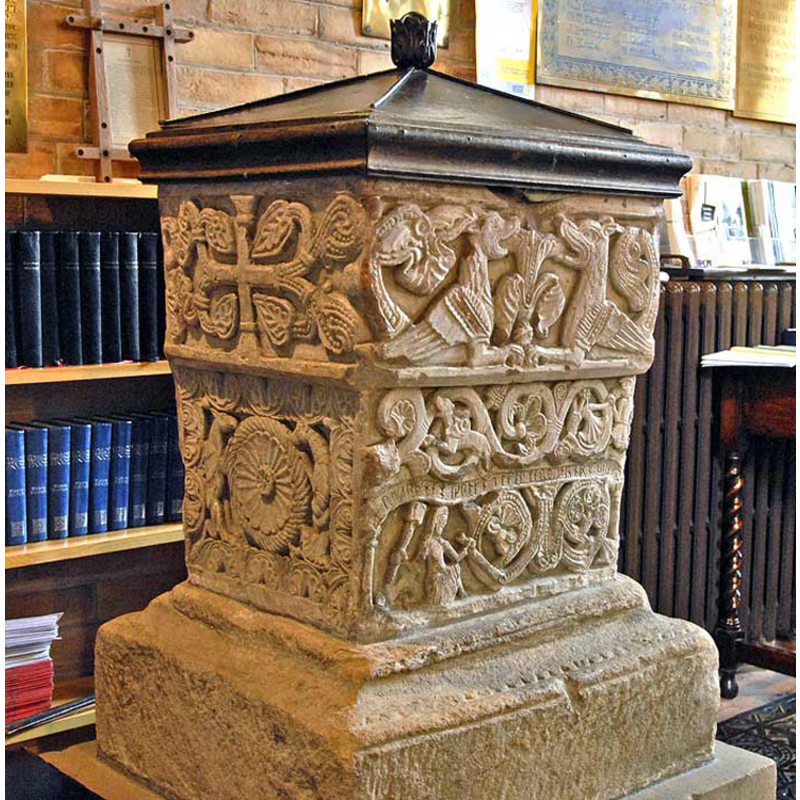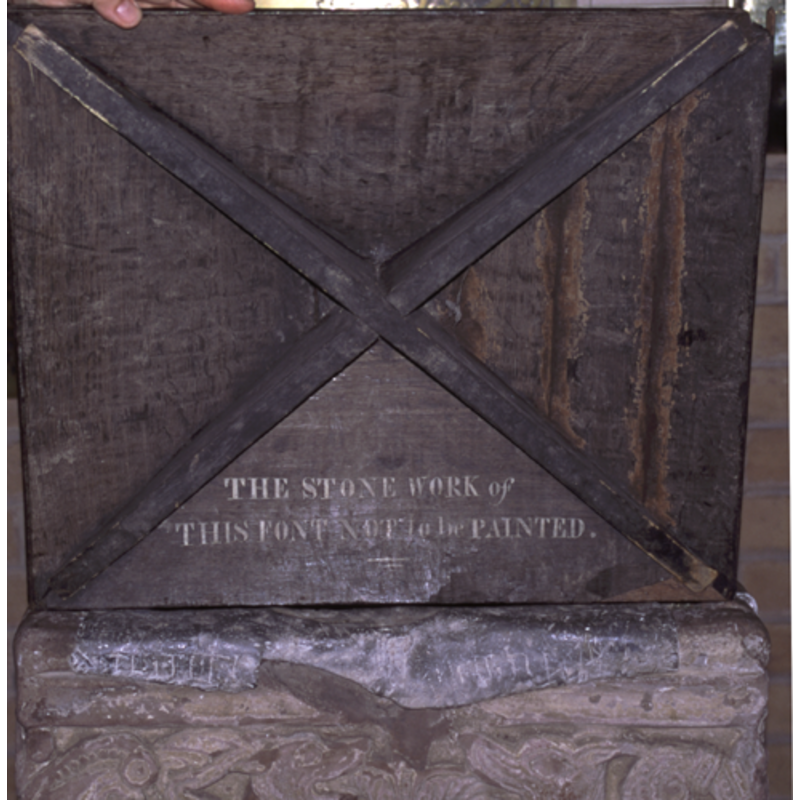Bridekirk

Image copyright © Baptisteria Sacra Index, 2023
Results: 55 records
B1R01: animal - fabulous animal or monster - dragon - facing each other - 2
Scene Description: south side: two facing dragons eat from a plant
Copyright Statement: Image copyright © Robert Rawlinson, 1999
Image Source: ddigital image of a detail of a B&W photograph taken in 1999 by Robert Rawlinson, Churchwarden, Bridekirk
Copyright Instructions: Photograph and permission received from the author (letter of January 12, 1999)
B1R02: animal - fabulous animal or monster - dragon - two-headed
Scene Description: east side: two-headed dragon with large and ornate coiled tail that ends in a cluster of leaves
Copyright Statement: Image copyright © Robert Rawlinson, 1999
Image Source: detail of a B&W photograph taken in 1999 by Robert Rawlinson, Churchwarden, Bridekirk
Copyright Instructions: Photograph and permission received from the author (letter of January 12, 1999)
B1R03: animal - fabulous animal or monster - centaur - basilisk - fighting
Scene Description: north side: a centaur in the centre fights a bird-head dragon (basilisk?) on the left, and another [reptile-like?] monster on the upper right
Copyright Statement: Image copyright © Robert Rawlinson, 1999
Image Source: detail of a B&W photograph taken in 1999 by Robert Rawlinson, Churchwarden, Bridekirk
Copyright Instructions: Photograph and permission received from the author (letter of January 12, 1999)
B1R04: symbol - cross - Greek - pattée - fleuronnée
Scene Description: west side: in the centre is a Greek potent cross which has acanthus-like plants sprouting only from the horizontal arms
Copyright Statement: Image copyright © Robert Rawlinson, 1999
Image Source: detail of a B&W photograph taken in 1999 by Robert Rawlinson, Churchwarden, Bridekirk
Copyright Instructions: Photograph and permission received from the author (letter of January 12, 1999)
B2R01: human figure - artisan - sculptor
Scene Description: south side, lower level: master Richard/Rikhart [of Durham?], identified by the inscription above, works with mallet and chisel on the vegetal ornamentation of the font in the lower part of the register
Copyright Statement: Image copyright © Adrian Fletcher, 2007
Image Source: digital photograph taken August 2007 by Adrian Fletcher [http://www.paradoxplace.com/Photo%20Pages/UK/Britain_Yorkshire_and_North/St_Bridget_Bridekirk/St_Bridgets_Bridekirk.htm] [accessed 27 December 2008]
Copyright Instructions: Permission received from the author (e-mail of 27 December 2008)
B2R02: New Testament - public life of Christ - baptism of Christ - in the Jordan - dove
Scene Description: east side: Baptism of Christ in the Jordan with John the Baptist holding a haloed child (?) Christ in the water; a disproportionately large bird (!), a dove, symbol of the Holy Ghost, above to the right, but touching [pecking?] Christ's head; trees on both sides, those on the left bearing fruit
Copyright Statement: Image copyright © Robert Rawlinson, 1999
Image Source: detail of a B&W photograph taken in 1999 by Robert Rawlinson, Churchwarden, Bridekirk
Copyright Instructions: Photograph and permission received from the author (letter of January 12, 1999)
B2R03: Old Testament - Genesis from the creation to the expulsion from paradise, and later years of Adam and Eve - Expulsion from Paradise - Angel with sword - Adam and Eve dressed - Tree on Knowledge
Scene Description: north side: possible representation of the Expulsion of Adam and Eve from Eden: the figure on the left (angel?) holds up a sword; in the centre a male figure (Adam?) looking left towards the angel (?); to his right, kneeling and appearing to hold the trunk of a tree [Tree of Knowledge?], a female figure (Eve?)
Copyright Statement: Image copyright © Adrian Fletcher, 2007
Image Source: digital photograph taken August 2007 by Adrian Fletcher [http://www.paradoxplace.com/Photo%20Pages/UK/Britain_Yorkshire_and_North/St_Bridget_Bridekirk/St_Bridgets_Bridekirk.htm] [accessed 27 December 2008]
Copyright Instructions: Permission received from the author (e-mail of 27 December 2008)
B2R04: design element - motifs - floral - rosette - fabulous animal or monster
Scene Description: west side: a square frame of vegetal motif contains a large rosette encircled in a round rope-motif frame and held on each side by a fabulous animal or monster [one a griffin?; the other a dragon?]
Copyright Statement: Image copyright © Robert Rawlinson, 1999
Image Source: detail of a B&W photograph taken in 1999 by Robert Rawlinson, Churchwarden, Bridekirk
Copyright Instructions: Photograph and permission received from the author (letter of January 12, 1999)
B2R05: design element - motifs - vine - acanthus - inhabited - human - fabulous animal or monster - fruit
Scene Description: south side, upper level: large vine inhabited by a human figure, a fabulous animal or monster, fruits, etc.
Copyright Statement: Image copyright © Robert Rawlinson, 1999
Image Source: detail of a B&W photograph taken in 1999 by Robert Rawlinson, Churchwarden, Bridekirk
Copyright Instructions: Photograph and permission received from the author (letter of January 12, 1999)
inscription
inscription
inscription
Scene Description: Illustration in John Bell (1773) ["The drawing of the south and north sides of this font were made this year by one Ainsley, apprentice to Mr. Jefferies; the other two sides by Mr. Elliott, employed by Jefferies to survey the county [...] The characters in which the inscription is contained are here transcribed from the accurate copy of them in the edition of the Britannia"]
Copyright Statement: Image copyright © [in the public domain]
Image Source: digital image of an illustration in John Bell (1773: pl. IX, p. 133)
Copyright Instructions: PD
inscription
inscription
view of basin - detail
view of basin - detail
view of church exterior
view of church exterior
view of font
Scene Description: Illustration in John Bell (1773) ["The drawing of the south and north sides of this font were made this year by one Ainsley, apprentice to Mr. Jefferies; the other two sides by Mr. Elliott, employed by Jefferies to survey the county [...] The characters in which the inscription is contained are here transcribed from the accurate copy of them in the edition of the Britannia"]
Copyright Statement: Image copyright © [in the public domain]
Image Source: digital image of an engraving in Archaeology vol. 2, pl. IX
Copyright Instructions: PD
view of font
view of font
Copyright Statement: Image copyright © [in the public domain]
Image Source: digital image of Orlando Jewitt's illustration in Charles MacFarlane, The Comprehensive History of England from the Earliest Period to the Reign of Edward VII King and Emperor (The Gresham Publishing Co., 1902)
Copyright Instructions: PD
view of font
view of font
view of font
view of font
view of font
view of font
view of font
view of font - detail
view of font - detail
Copyright Statement: Image copyright © Adrian Fletcher, 2007
Image Source: digital photograph taken August 2007 by Adrian Fletcher [http://www.paradoxplace.com/Photo%20Pages/UK/Britain_Yorkshire_and_North/St_Bridget_Bridekirk/St_Bridgets_Bridekirk.htm] [accessed 27 December 2008]
Copyright Instructions: Permission received from the author (e-mail of 27 December 2008)
view of font - detail
Copyright Statement: Image copyright © Adrian Fletcher, 2007
Image Source: digital photograph taken August 2007 by Adrian Fletcher [http://www.paradoxplace.com/Photo%20Pages/UK/Britain_Yorkshire_and_North/St_Bridget_Bridekirk/St_Bridgets_Bridekirk.htm] [accessed 27 December 2008]
Copyright Instructions: Permission received from the author (e-mail of 27 December 2008)
view of font - detail
Scene Description: the scene usually identified as the Expulsion from Paradise
Copyright Statement: Image copyright © Adrian Fletcher, 2007
Image Source: digital photograph taken August 2007 by Adrian Fletcher [http://www.paradoxplace.com/Photo%20Pages/UK/Britain_Yorkshire_and_North/St_Bridget_Bridekirk/St_Bridgets_Bridekirk.htm] [accessed 27 December 2008]
Copyright Instructions: Permission received from the author (e-mail of 27 December 2008)
view of font - east side
view of font - east side
view of font - east side
view of font - east side
Scene Description: Illustration in John Bell (1773) ["The drawing of the south and north sides of this font were made this year by one Ainsley, apprentice to Mr. Jefferies; the other two sides by Mr. Elliott, employed by Jefferies to survey the county [...] The characters in which the inscription is contained are here transcribed from the accurate copy of them in the edition of the Britannia"]
Copyright Statement: Image copyright © [in the public domain]
Image Source: digital image of an illustration in John Bell (1773: pl. IX, p. 133)
Copyright Instructions: PD
view of font - north side
view of font - north side
view of font - north side
view of font - north side
Scene Description: Illustration in John Bell (1773) ["The drawing of the south and north sides of this font were made this year by one Ainsley, apprentice to Mr. Jefferies; the other two sides by Mr. Elliott, employed by Jefferies to survey the county [...] The characters in which the inscription is contained are here transcribed from the accurate copy of them in the edition of the Britannia"]
Copyright Statement: Image copyright © [in the public domain]
Image Source: digital image of an illustration in John Bell (1773: pl. IX, p. 133)
Copyright Instructions: PD
view of font - north side
view of font - south side
view of font - south side
view of font - south side
view of font - south side
Scene Description: Illustration in John Bell (1773) ["The drawing of the south and north sides of this font were made this year by one Ainsley, apprentice to Mr. Jefferies; the other two sides by Mr. Elliott, employed by Jefferies to survey the county [...] The characters in which the inscription is contained are here transcribed from the accurate copy of them in the edition of the Britannia"]
Copyright Statement: Image copyright © [in the public domain]
Image Source: digital image of an illustration in John Bell (1773: pl. IX, p. 133)
Copyright Instructions: PD
view of font - south side - detail
view of font - west side
view of font - west side
view of font - west side
view of font - west side
Scene Description: Illustration in John Bell (1773) ["The drawing of the south and north sides of this font were made this year by one Ainsley, apprentice to Mr. Jefferies; the other two sides by Mr. Elliott, employed by Jefferies to survey the county [...] The characters in which the inscription is contained are here transcribed from the accurate copy of them in the edition of the Britannia"]
Copyright Statement: Image copyright © [in the public domain]
Image Source: digital image of an illustration in John Bell (1773: pl. IX, p. 133)
Copyright Instructions: PD
view of font and cover
Copyright Statement: Image copyright © Adrian Fletcher, 2007
Image Source: digital photograph taken August 2007 by Adrian Fletcher [http://www.paradoxplace.com/Photo%20Pages/UK/Britain_Yorkshire_and_North/St_Bridget_Bridekirk/St_Bridgets_Bridekirk.htm] [accessed 27 December 2008]
Copyright Instructions: Permission received from the author (e-mail of 27 December 2008)
INFORMATION
FontID: 00135BRI
Object Type: Baptismal Font1
Church/Chapel: Parish Church St. Bridget
Church Patron Saints: St. Brigid of Ireland [aka Brigit, Bridget, Bride, Brydoch, Brydock, Ffraed, Ffraid, Fraed]
Church Location: Bridekirk, Cumbria CA13 0NY, United Kingdom
Country Name: England
Location: Cumbria, North West
Directions to Site: Bridekirk is located off (W) the A495, 3-4 km N of Cockermouth and the Derwent river, 40-45 km SW of Carlisle
Ecclesiastic Region: Diocese of Carlisle
Historical Region: Union of Cockermouth, Ward of Allerdale -- formerly Cumberland
Font Location in Church: Inside the church, in the SW corner of the nave, just inside the main entranceway
Date: ca. 1150?
Century and Period: 12th century (mid?), Norman
Workshop/Group/Artisan: Master Richard [aka Ekard / Rikarth of Durham?]
Cognate Fonts: Harpole (Northants.) & Haddenham (Bucks.)
Credit and Acknowledgements: We are grateful for the photographs of this font supplied by Mr. Rawlinson, churchwarden of St Bridget's, and his ingenuity in managing to get a useful image of the back side of the font using a large mirror for the shot [image shown was reversed and righted. We are also grateful to Mr. Rawlinson for his further contributions regarding other fonts in the area] -- [We are grateful to the Thomas Fisher Rare Books Library for access to the copy of Lysons’ Magna Britannia, and to Jim Ingram, of the Preservation Services, Robarts Library, for the digital imaging of Lysons’ illustrations.
Church Notes: the ruins of the 12thC church are within the churchyard of the present church [cf. www.britishlistedbuildings.co.uk/en-72573-ruin-of-church-of-st-bridget-bridekirk-cu] [accessed 7 January 2012]
Font Notes:
Click to view
No individual entry for Bridekirk found in the Domesday survey. Early references to this font, especially to its Runic inscription, can be found in Camden's Britannia (1607) and in Gibson's (1753) edition of the same, in Lyttelton (1773), in Milner (1796), in Hutchinson and Gough (1796), in Denne (1797), in Howard (1803), in Sheahan & Whellan (1857), and in an image of the font and inscription attributed to Smith of Wigton (1749). The entry for West Tanfield in Whitaker (1823) mentions "the celebrated font at Bridekirk", on which "the Danes call themselves Taner Men". Palgrave (1876) refers to an interpretation of the Runes on this font by Ole Worm [aka Olaus Wormius] (1588-1655): "Attend to Olaus Wormius, and it signifies,—"Harold made this heap, and raised these stones, in honour of his mother and of Mabrok", and adds a number of later interpretations including the one put forth by Bishop Nicholson [cf. infra]. An article in the Gentleman's Magazine (vol. 9, January 1739, p. 11) has: "that famous old font in Bridekirk in Cumberland, which seems by the inscription to be erected upon the most early conversion of the Saxons to Christianity; where as Bishop Nicholson observes, 'we have on the East side fairly represented a person in a long sacerdotal habit dipping a Child into the water and a dove (the emblem, no doubt, of the Holy Ghost, hovering over the Infant'. They are the words of the Bishop to Sir William Dugdale, the famous antiquarian, and are to be found in Gibson's Camden, p. 841". The issue of the Gentleman's Magazine for April 1749 (vol. 19, pl. v) has an illustration of the font, and the next issue (May 1749, p. 217) has a description of the font and a note on the inscription, as well as it claims to correct several errors in earlier notes on this font. This baptismal font is described and illustrated in Lysons (1806-1833) as "probably the most curious one in the kingdom [...], enriched with sculptures in bas-relief, the style of which would clearly indicate it to be the work of an earlier age than that of the Norman conquest, if it had not the Dano-Saxon inscription on the south side, in Runic characters; which was first satisfactorily explained by Bishop Nicholson, in a letter to Sir William Dugdale, published in the fifteenth volume of the Philosophical Transactions. He reads it thus, "Er Ekard, han men egrocten, and to dis men red wer Taner men brogton;" i.e. "Here Ekard was converted , and to this man's example were the Danes brought". The scroll on which this inscription is cut rests on two pillars, one of which is evidently clustered , and of a lighter style than that which prevailed a short time before the Conquest." On the origin of this font Lysons (ibid.) add: "Camden says that this font was found in the Roman station at Papcastle, but this is doubted by Bishop Lyttelton, as there had never been a church or chapel there; his Lordship supposes the font to have been of higher antiquity, and that the inscription was added about the beginning of the eleventh century, under the Danish government. But this is very improbable, as the scroll which contains the inscription, is evidently part of the original design. If the font was really found at Papcastle, according to the tradition, it must have been in the chapel of the castle belonging to the Saxon lords of Allerdale, which is not very probable; it is much more likely that it should have been a donation to the church, where it remains, by Ekard, who had embraced Christianity, and who no doubt was a person of consequence." Noted and illustrated in Britton's Dictionary of 1838, after Camden and Bishop Littleton, and with reference also to Robinson's History of Baptism of 1790. In Poole (1842). Pugin (1843) reported a salamander on it. The font is noted in Mannix & Whellan's Directory of Cumberland of 1847 [cf. 2003 transcription by Steve Bulman www.stevebulman.f9.co.uk/cumbria/bridekirk.html]. Orlando Jewitt's drawing was used in MacFarlane's Comprehensive History of England (1902). Described in Cox & Harvey (1907) as a small but finely sculptured square font, all four sides elaborately carved; the Baptism of Christ is depicted on one side; on the opposite, the expulsion of Adam and Eve from Paradise; a third side has the inscription and shows master Richard (Rikarth) working at the foliage; the language of the inscription is a mixed dialect of Old Norse and Old English. Cox & Harvey (ibid.) suggest that Master Rikarth may have been the Richard recorded as master of works to Bishop Pudsey in the improvements to Norham Castle, 1150-1170; they also write: "The font at Bridekirk, Cumberland, with a runic inscription, was long supposed to be of very early date, but the best experts seem now agreed that the runes are of the 12th century." Cox (1913) describes it as "perhaps [...] the most valuable in England", but dates it to the 13th century, although, in the same source, Cox states that "the dialect and style make it 12th cent." Forbes & Dickins (1914) study the inscription on this font as well as those on the crosses at Ruthwell and Bewcastle. Tyrrell-Green (1928) records the inscription and gives an English translation; he comments: "The inscription is in runic letters, partly Scandinavian, and the dialect is that of the twelfth century; the Richard mentioned may, therefore, have been Richard of Durham, known as an architect and sculptor (1120-80)". On-site notes: the basin is lead lined, the lining now overlaps the upper rim. The font cover, of quasi-flat pyramidal shape, bears a warning on the inside: "The stone of this font not to be painted", a directive one hopes is followed by all future minders of the font. Pevsner (1967) comments on the general look of this font: "The style is that of Yorkshire, the decoration has Italian touches." In Torrens Alzu (2007).
COORDINATES
Church Latitude & Longitude Decimal: 54.690661, -3.371214
Church Latitude & Longitude DMS: 54° 41′ 26.38″ N, 3° 22′ 16.37″ W
UTM: 30U 476072 6060433
MEDIUM AND MEASUREMENTS
Material: stone, limestone
Number of Pieces: one
Font Shape: square (mounted)
Basin Interior Shape: square
Basin Exterior Shape: square
Drainage Notes: lead lining
Rim Thickness: 8.25 cm
Diameter (inside rim): 42.54 x 31.75 cm
Basin Depth: 22-26 cm
Height of Basin Side: 61 cm
Basin Total Height: 61cm
Height of Base: 31.75 cm
Basin Upper Panel Dimensions: 30 cm
Basin Lower Panel Dimensions: 31 cm
Font Height (less Plinth): 92. 75 cm
Font Height (with Plinth): 111.75 cm
Trapezoidal Basin: 56.51 x 46.99 cm
Notes on Measurements: Supplied by Mr. Robert Rawlinson, churchwarden at Bridekirk, July 2000 [Romily Allen (1888: 165) gives: external basin: 1' 9" x 1' 6" x (height of basin + base) 2' 10" and height of base 11" [= in cm: 52 x 45 x 85 and 27.5]]
INSCRIPTION
Inscription Language: Old English - Old Norse - runes
Inscription Notes: Transl.: 1. (Cox): "Richard he me wrought/ And to this beauty carefully me brought" - 2. (T-G.): "Richard he me worught / And to this excellence diligently me brought" - 3. (Lysons): "Here Ekard was converted, and to this man's example the Danes brought". [cf. Image area for view of Runic original]
Inscription Location: South side (of four)
Inscription Text: 1) Cox & Harvey: "RIKARTH HE ME IWROKTE / & TO THIS MERTHE GERNR ME BROKTE"
2) Tyrrell-Green: "+ RICARTH : HE : ME : IWRUCTE : AND : TO : THIS : MERETH : GERNR : ME : BROCTE :"
3) Lysons: "ER EKARD HAN MEN EGROCTEN AND TO DIS MEN RED WER TANER MEN BROGTON"
4)Forbes & Dickins: "+ RIKARTH HE ME IWROKT(E) / AND TO THIS MERTHR GERNR ME / BROKTE"
Inscription Source: 1. Cox & Harvey (1907: 178) - 2. Tyrrell-Green (1928: 150) - Romilly Allen (1888: 165); confirmed by mail form from Robert Rawlinson, churchwarden at Bridekirk [see BSI archive and copyright of images]. 3.- Lysons (1806-1833, vol. IV: cxciii). 4.- Forbes & Dickins (1914: 26)
LID INFORMATION
Date: modern
Material: wood
Apparatus: none
Notes: Bears printed inscription on the inside: 'THE STONE WORK OF THIS FONT NOT TO BE PAINTED"
REFERENCES
Allen, J. Romilly, "Notes on Early Christian Symbolism", N.S., VI, Proceedings of the Society of Antiquaries of Scotland, 1884, pp. 380-464; p. 406fn2, 420fn3
Allen, J. Romilly, "On the Antiquity of Fonts in Great Britain", XLIV, Journal of the British Archaeological Association, 1888, pp. 164-173; p. 164, 165
Bell, John, "Extract of a letter from the Rev. Mr. John Bell, Vicar of Bridekirk, who communicated the annexed Draughts of this font", II, Archaeologia, 1773, pp. 133; p. 133 and pl. IX
Bloxam, Matthew Holbeche, The Principles of Gothic ecclesiastical architecture, with an explanation of technical terms […], London: W. Kent, 1859
Bond, Francis, Fonts and Font Covers, London: Waterstone, 1985 c1908
Britton, John, A Dictionary of the Architecture and Archaeology of the Middle Ages, including […], London: Longman, Orne, Brown, Green, and Longmann, Paternoster Row, and the Author, Burton Street, 1838
Bulmer, T., History and Directory of Cumberland, 1901
Calverley, William Slater, Notes on the early sculptured crosses, shrines and monuments in the present diocese of Carlisle, Kendal: T. Wilson, 1899
Camden, William, Britannia, or, chorographical description of Great Britain and Ireland, London: printed for R. Ware, [et al.], 1753
Clapham, Alfred William, English Romanesque Architecture after the Conquest, Oxford: Clarendon Press, 1934
Cox, John Charles, Cumberland and Westmorland, London: George Allen & Co. Ltd., 1913
Cox, John Charles, English Church Furniture, New York: E.P. Dutton & Co., 1907
Davies, J.G., The Architectural Setting of Baptism, London: Barrie and Rockliff, 1962
Denne, Samuel, "Bridekirk font", LXVII, i, The Gentleman's Magazine: or, Trader's monthly intelligencer, 1797, pp. 37-38; p. 37-38
Forbes, M.D., "The inscriptions of the Ruthwell and Bewcastle crosses and the Bridekirk font", XXV, 133, The Burlington Magazine for Connoisseurs, 1914, pp. 24-29; p. 24-29
Friar, Stephen, The Sutton Companion to Churches, Thrupp, Stroud (Gloucs.): Sutton Publishing, 2003
Gough, Richard, "Response to [William] Hutchinson re Bridekirk font", LXVI, ii, The Gentleman's Magazine: or, Trader's monthly intelligencer, 1796, pp. 1079; p. 1079
Hamper, William, "The Runic inscription on the font at Bridekirk considered and a new interpretation [...]", XIX, Archaeologia, 1821, pp. [??]; [unavailable]
Howard, H., "Observations on Bridekirk font and on the runic column at Bewcastle, in Cumberland", XIV, Archaeologia, 1803, pp. 113-118; p. 113-118
Kroesen, Justin E.A., The Interior of the medieval village church = Het middeleeuwse Dorpskerkinterieur, Leuven: Uitgeverij Peeters, 2004
Lowthian [of Kellington], John, "On ablution, baptism, fonts, &c.", 95-ii, December 1825, The Gentleman's Magazine: or, Trader's monthly intelligencer, 1825, pp. 511-512; p. 512
Lysons, Daniel, Magna Britannia, being a concise topographical account of the several counties of Great Britain, London: Printed for T. Cadell and W. Davies, 1806-1822
Lyttelton, [Bishop], "Description of an ancient font at Bridekirk, in Cumberland", II, Archaeologia, 1773, pp. 131-133; p. 131-133
Mannix, History, gazetteer and directory of Cumberland, Cumberland: Michael Moon, 1974 c1847
Moule, Thomas, The English counties delineated; or, A topographical description of England [...], London: George Virtue, 1837 [vol. 2]
Paley, Frederick Apthorp, Illustrations of Baptismal Fonts, London, UK: John van Voorst, 1844
Palgrave, Francis, Sir, History of the Anglo-Saxons, London: William Tegg & Co., 1876
Parker, John Henry, A Glossary of Terms used in Grecian, Roman, Italian and Gothic Architecture, Oxford: J. H. Parker, 1850
Pevsner, Nikolaus, Cumberland and Westmorland, Harmondsworth: Penguin Books, 1967
Poole, George Ayliffe, The Appropriate Character of Church Architecture, Leeds; London: T.W. Green; Rivington, Burns, and Houlston and Stoneman, 1842
Pudelko, Georg, Romanische Taufsteine, Berlin: Wurfel Verlag, 1932
Pugin, Augustus Northmore Welby, The Present State of Ecclesiastical Architecture in England, London: Charles Dolman, 1843
Smith of Wigton (?), George, "View of an ancient font at Bridekirk in Cumberland, with a Runic inscription", 19, The Gentleman's Magazine: or, Trader's monthly intelligencer, 1749, pp. Fig. V, opp. p. 152; fig. v, opp. p. 152
Stocker, D.A., "Fons et origo: The Symbolic Death and Resurrection of English Font Stones", I (1997b), Church Archaeology, 1997, pp. 17-25; p. 22ff
Torrens Alzu, Miguel A., "La pila bautismal de Bridekirk: ‘vas patens e saxo subviridi’ con autorretrato de Richardus de Durham", 4 (Junio 2007), Románico: revista de arte de Amigos del Románico, 2007, pp. 42-47; p. 42-47
Tyrrell-Green, E., Baptismal Fonts Classified and Illustrated, London: Society for Promoting Christian Knowledge: The Macmillan Co., 1928
Wagner, Ann Kelly, "An Investigation of the Twelfth Century Baptismal Font in the Parish Church in Bridekirk, Cumbria", Washington, 1996
Whellan & Co., T., History and topography of the city of York and the North Riding of Yorkshire, embracing a […], Beverley: printed for the publishers by John Green, Market Place, 1859
Whitaker, Thomas Dunham, An history of Richmondshire, in the North Riding of the County of York [...], with illustrations by J.M.W. Turner, London: [s.n.], 1823
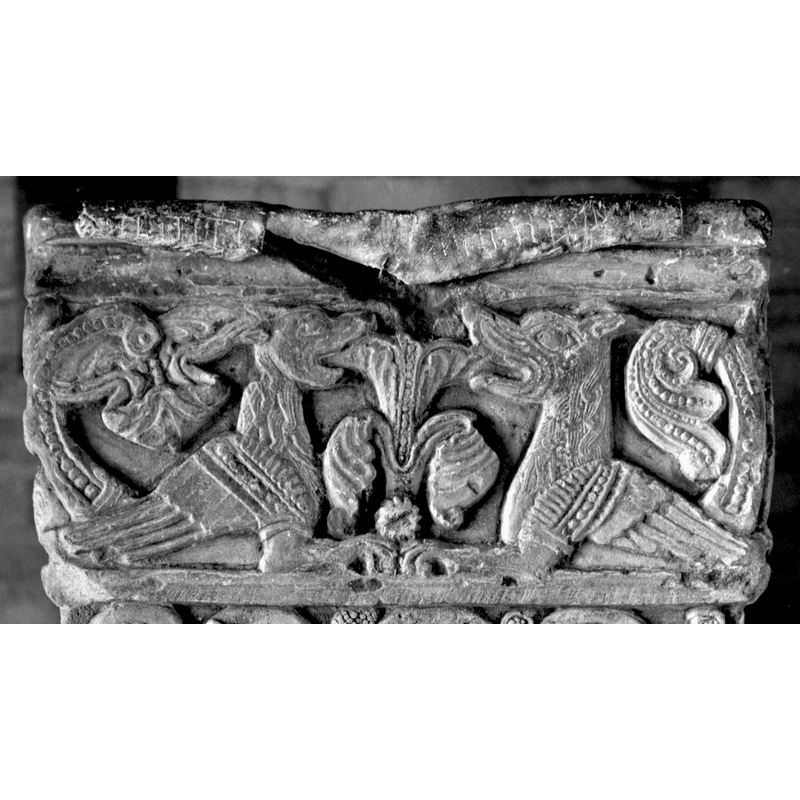

![north side: a centaur in the centre fights a bird-head dragon (basilisk?) on the left, and another [reptile-like?] monster on the upper right](/static-50478a99ec6f36a15d6234548c59f63da52304e5/compressed/1060803004_compressed.png)
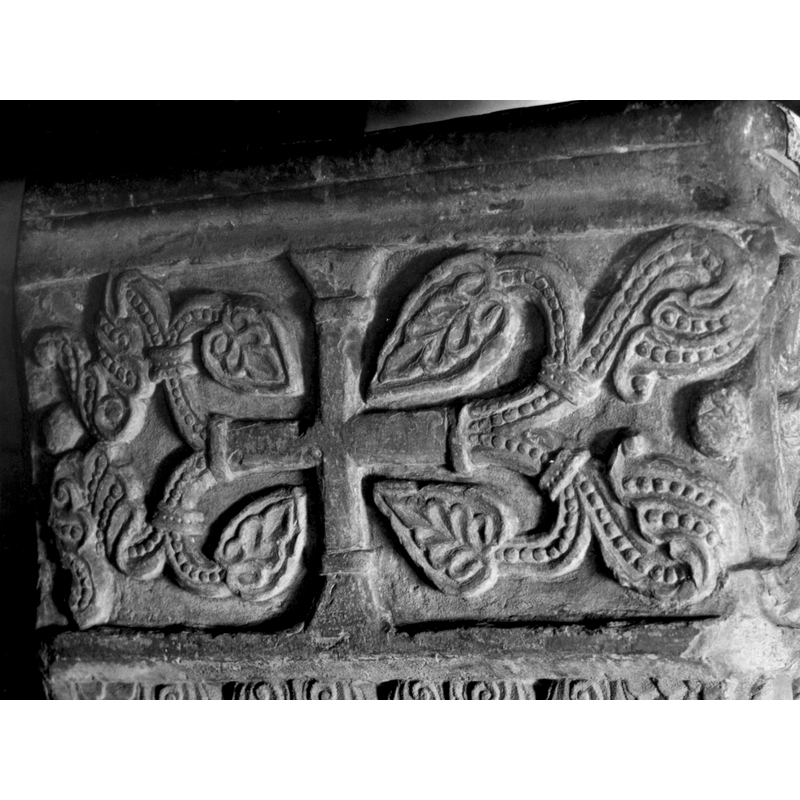
![south side, lower level: master Richard/Rikhart [of Durham?], identified by the inscription above, works with mallet and chisel on the vegetal ornamentation of the font in the lower part of the register](/static-50478a99ec6f36a15d6234548c59f63da52304e5/compressed/1081228006_compressed.png)
![east side: Baptism of Christ in the Jordan with John the Baptist holding a haloed child (?) Christ in the water; a disproportionately large bird (!), a dove, symbol of the Holy Ghost, above to the right, but touching [pecking?] Christ's head; trees on both sides, those on the left bearing fruit](/static-50478a99ec6f36a15d6234548c59f63da52304e5/compressed/1060803007_compressed.png)
![north side: possible representation of the Expulsion of Adam and Eve from Eden: the figure on the left (angel?) holds up a sword; in the centre a male figure (Adam?) looking left towards the angel (?); to his right, kneeling and appearing to hold the trunk of a tree [Tree of Knowledge?], a female figure (Eve?)](/static-50478a99ec6f36a15d6234548c59f63da52304e5/compressed/1081228004_compressed.png)
![west side: a square frame of vegetal motif contains a large rosette encircled in a round rope-motif frame and held on each side by a fabulous animal or monster [one a griffin?; the other a dragon?]](/static-50478a99ec6f36a15d6234548c59f63da52304e5/compressed/1060803009_compressed.png)

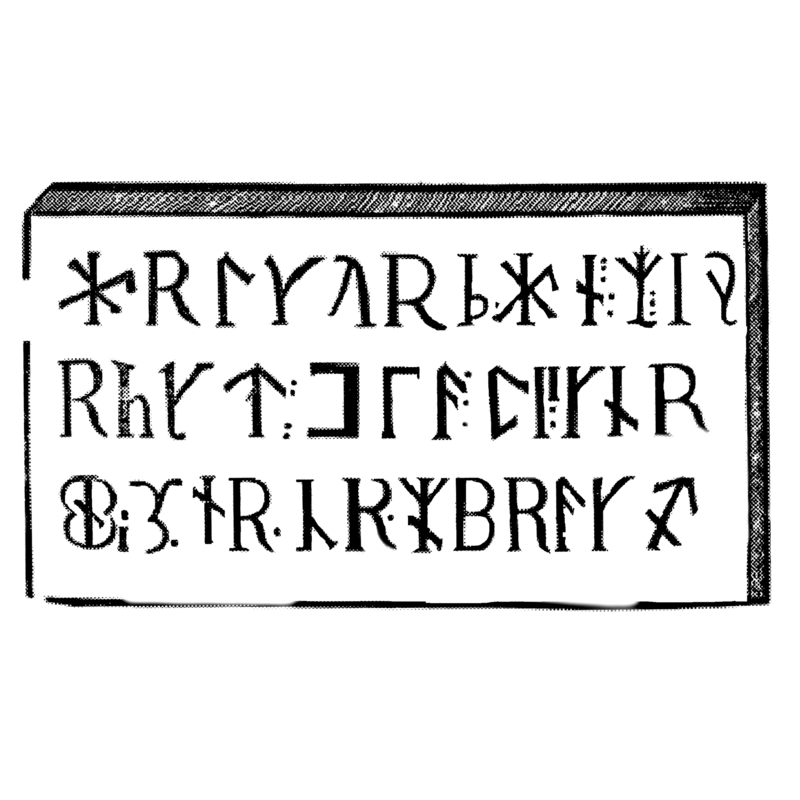
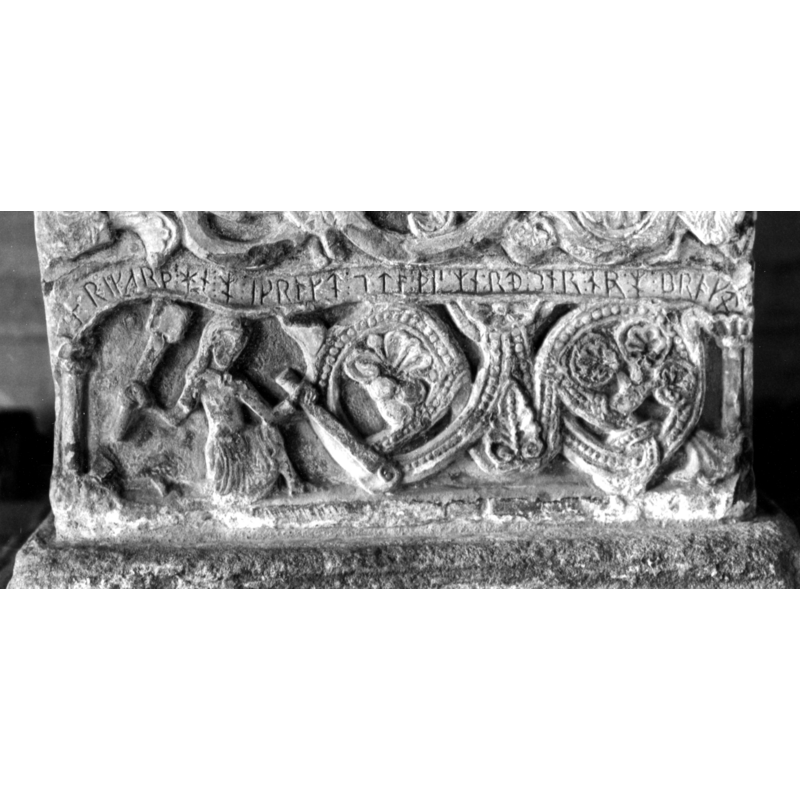
![Illustration in John Bell (1773) ["The drawing of the south and north sides of this font were made this year by one Ainsley, apprentice to Mr. Jefferies; the other two sides by Mr. Elliott, employed by Jefferies to survey the county [...] The characters in which the inscription is contained are here transcribed from the accurate copy of them in the edition of the Britannia"]](/static-50478a99ec6f36a15d6234548c59f63da52304e5/compressed/1050221006_compressed.png)
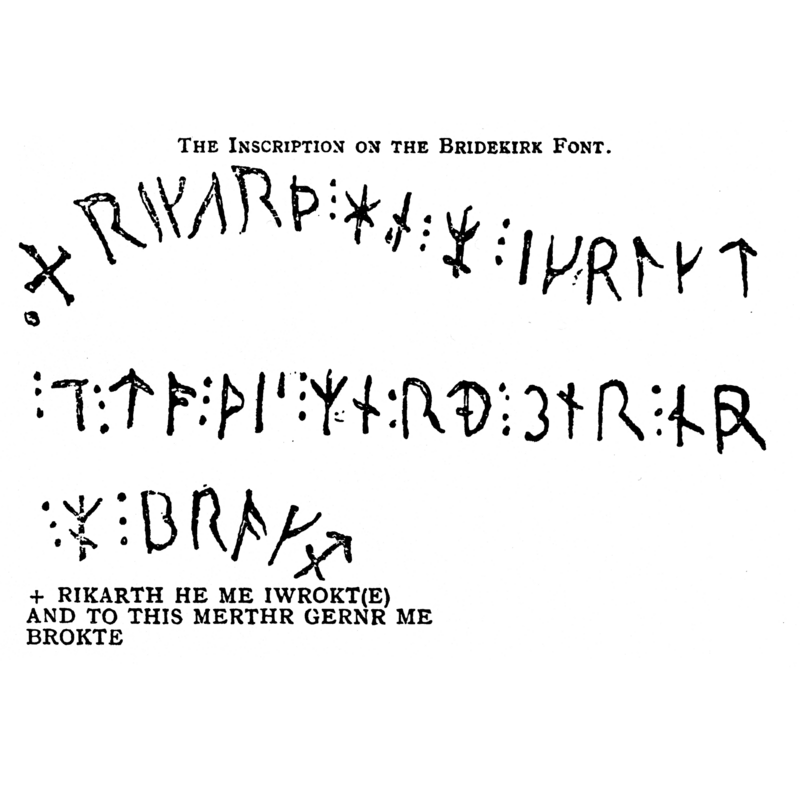
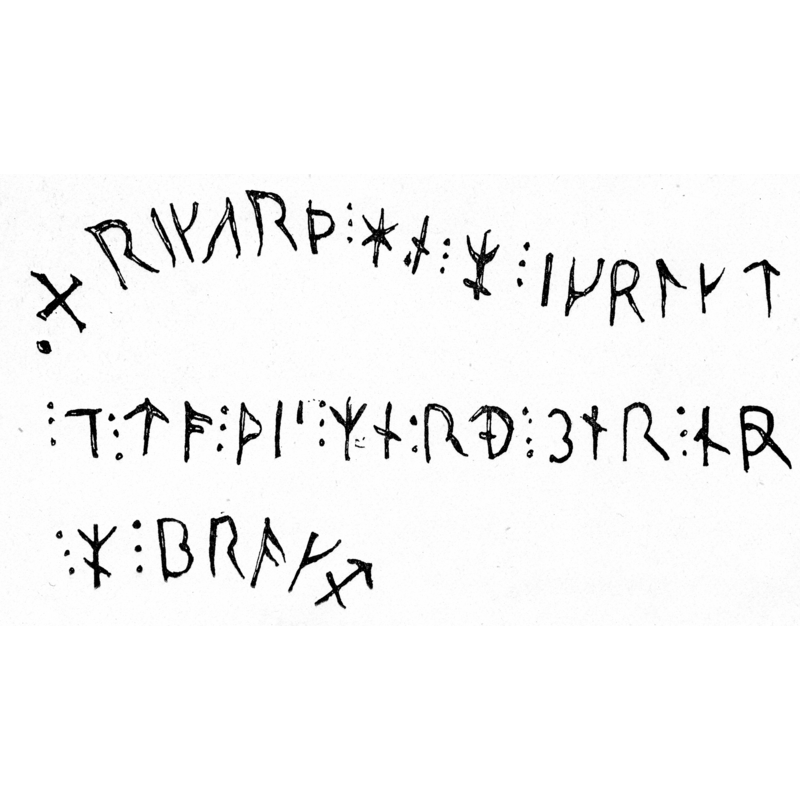
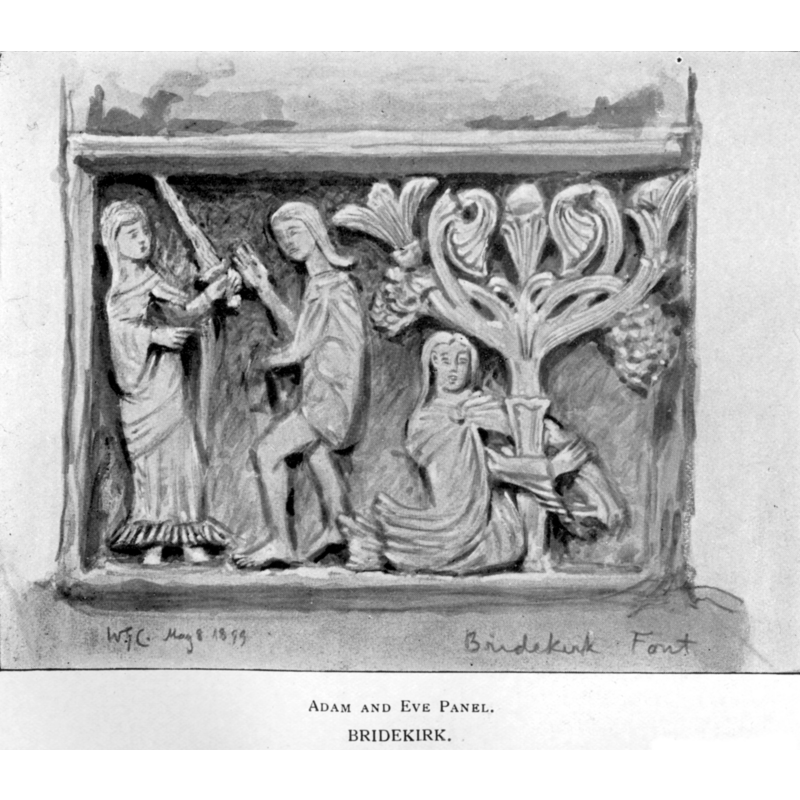
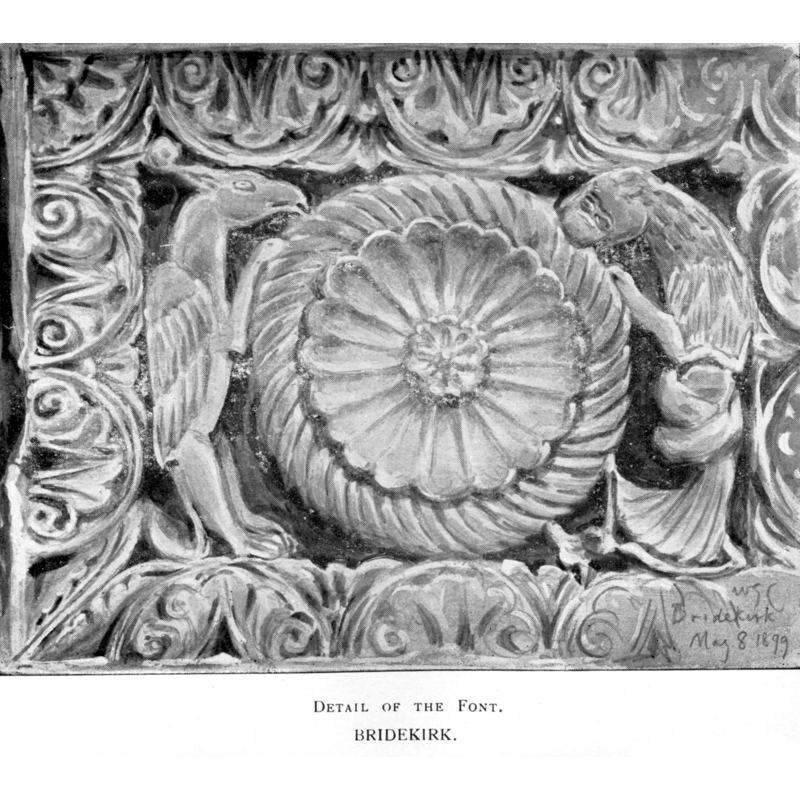

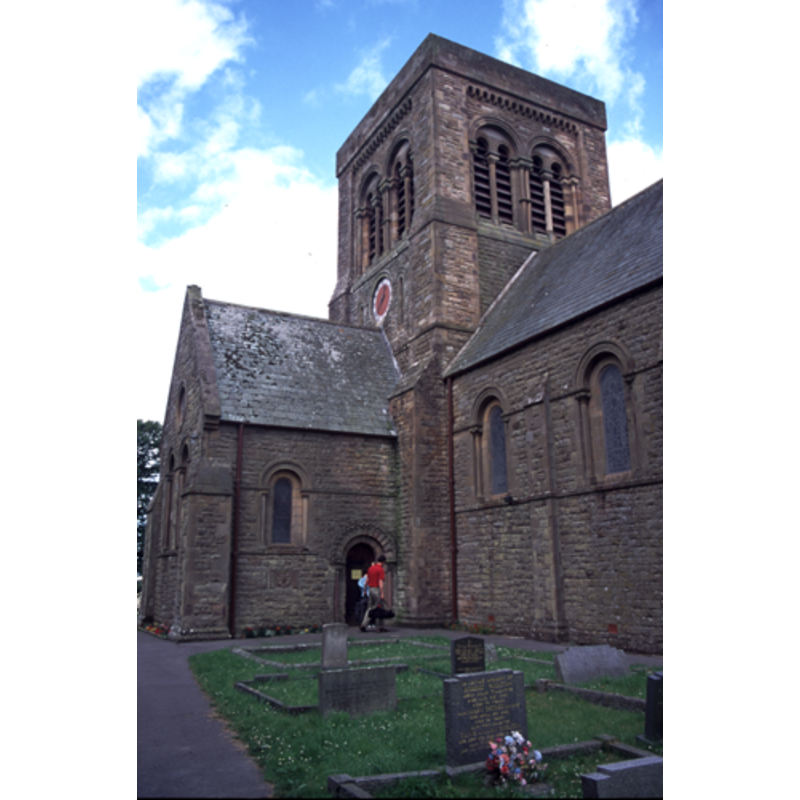
![Illustration in John Bell (1773) ["The drawing of the south and north sides of this font were made this year by one Ainsley, apprentice to Mr. Jefferies; the other two sides by Mr. Elliott, employed by Jefferies to survey the county [...] The characters in which the inscription is contained are here transcribed from the accurate copy of them in the edition of the Britannia"]](/static-50478a99ec6f36a15d6234548c59f63da52304e5/compressed/0040706005_compressed.png)



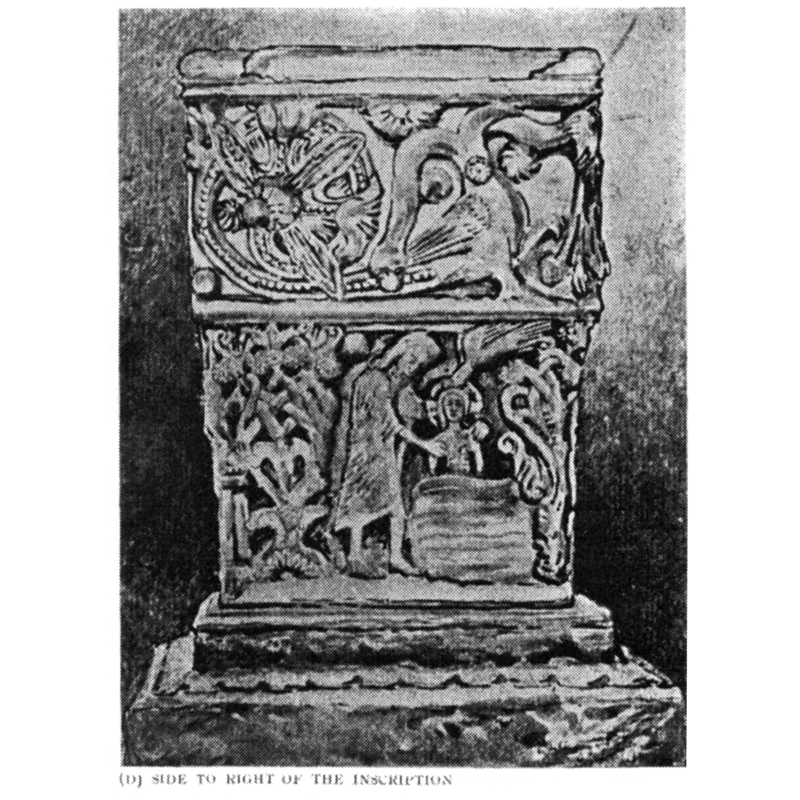
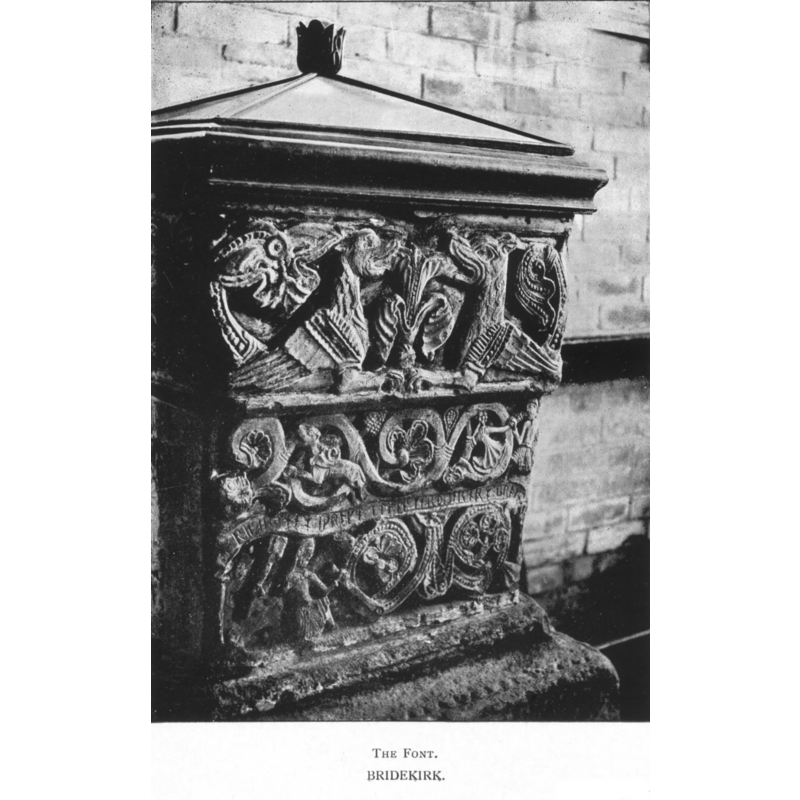

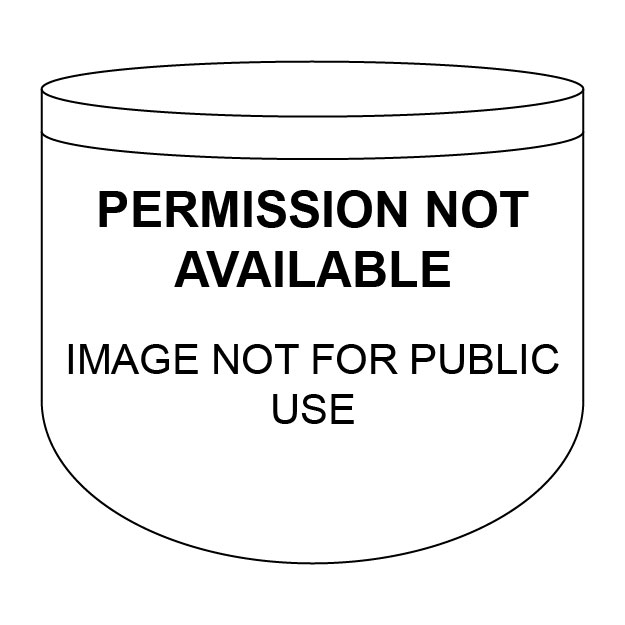
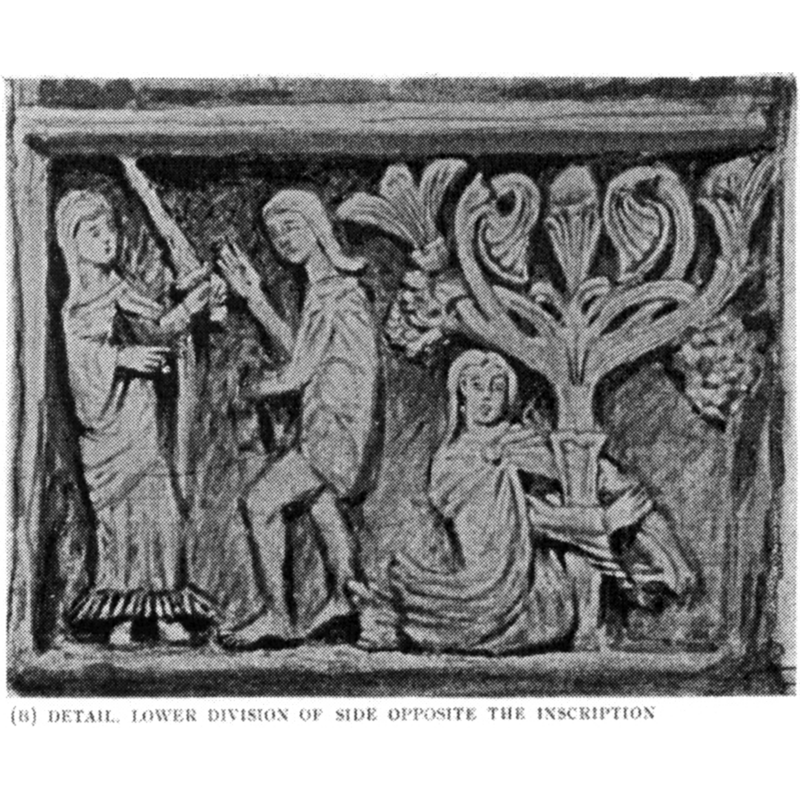
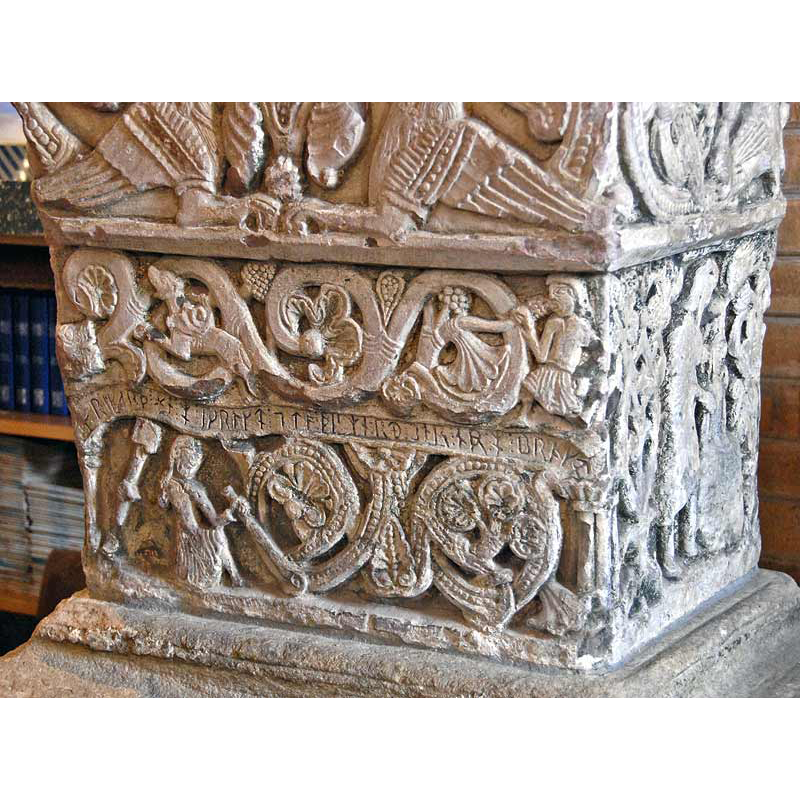

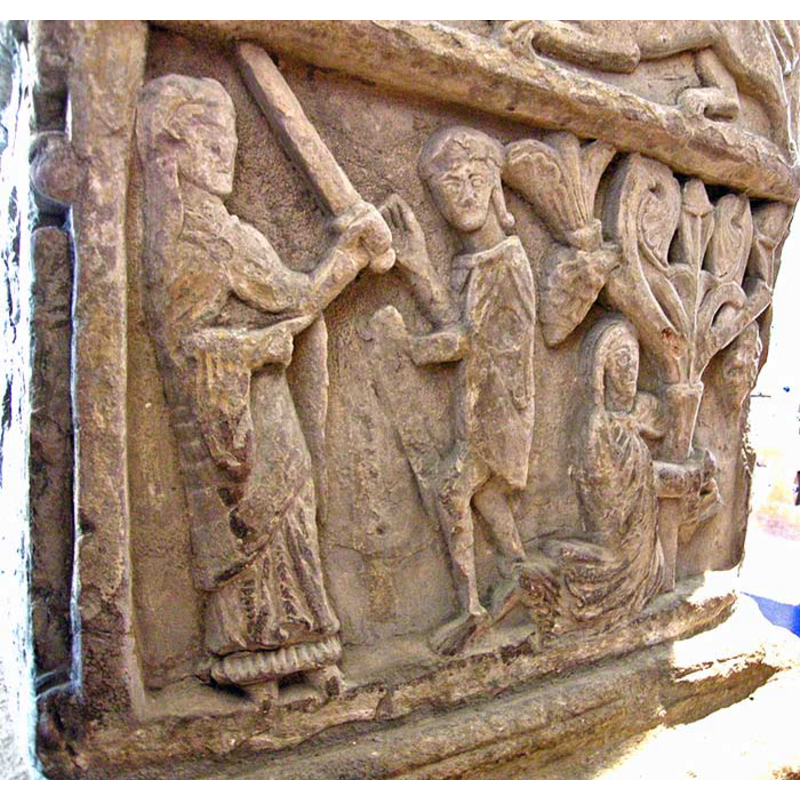


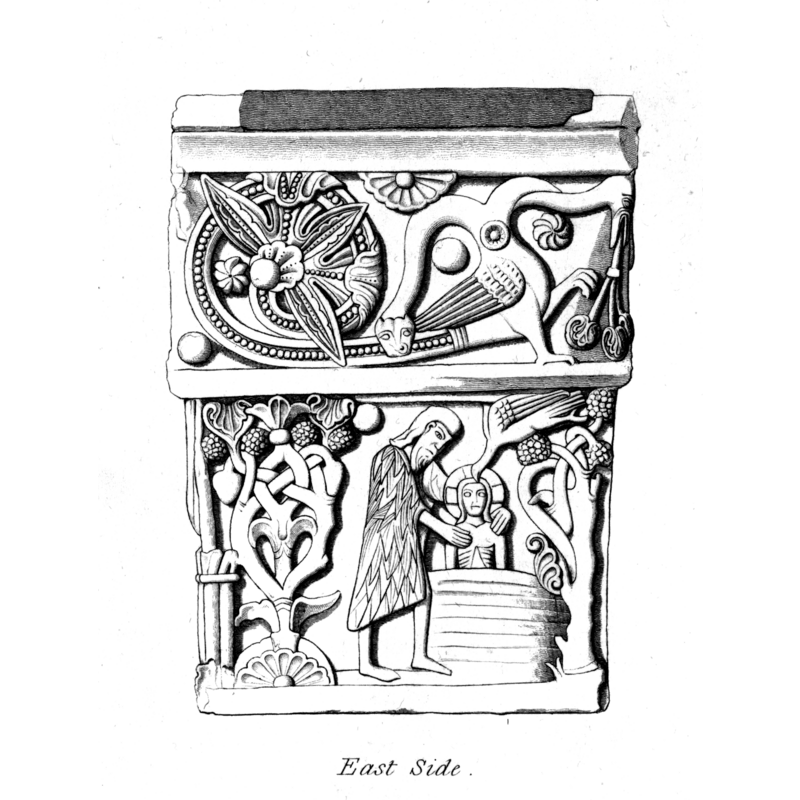
![Illustration in John Bell (1773) ["The drawing of the south and north sides of this font were made this year by one Ainsley, apprentice to Mr. Jefferies; the other two sides by Mr. Elliott, employed by Jefferies to survey the county [...] The characters in which the inscription is contained are here transcribed from the accurate copy of them in the edition of the Britannia"]](/static-50478a99ec6f36a15d6234548c59f63da52304e5/compressed/1050221002_compressed.png)
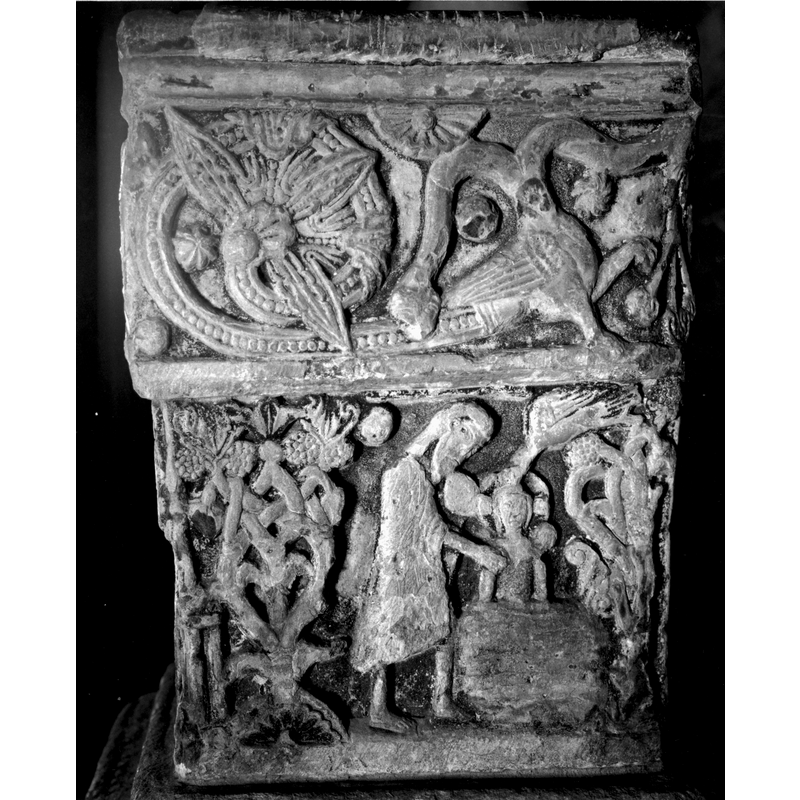

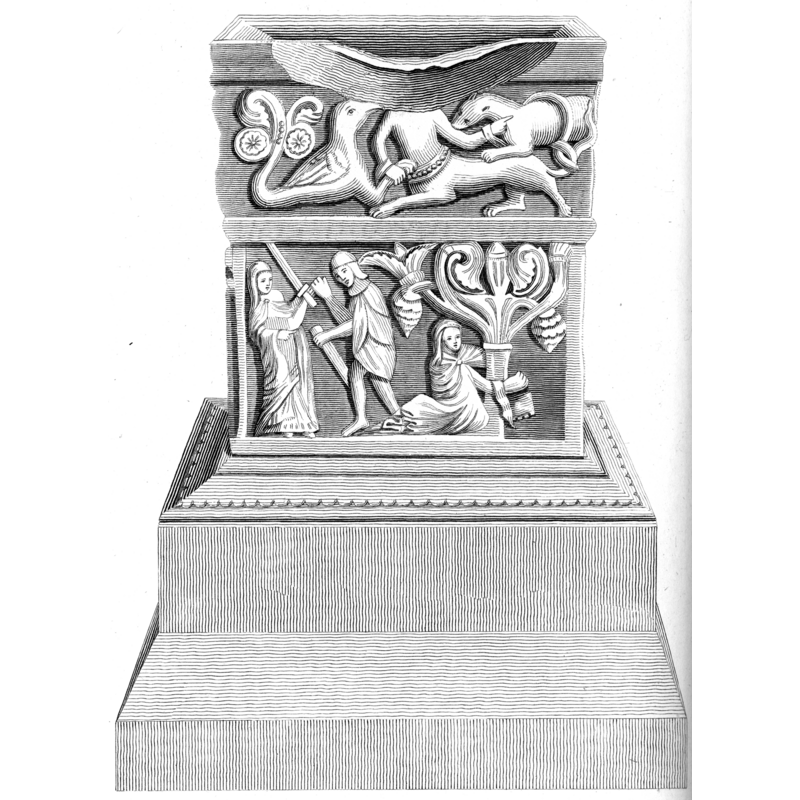
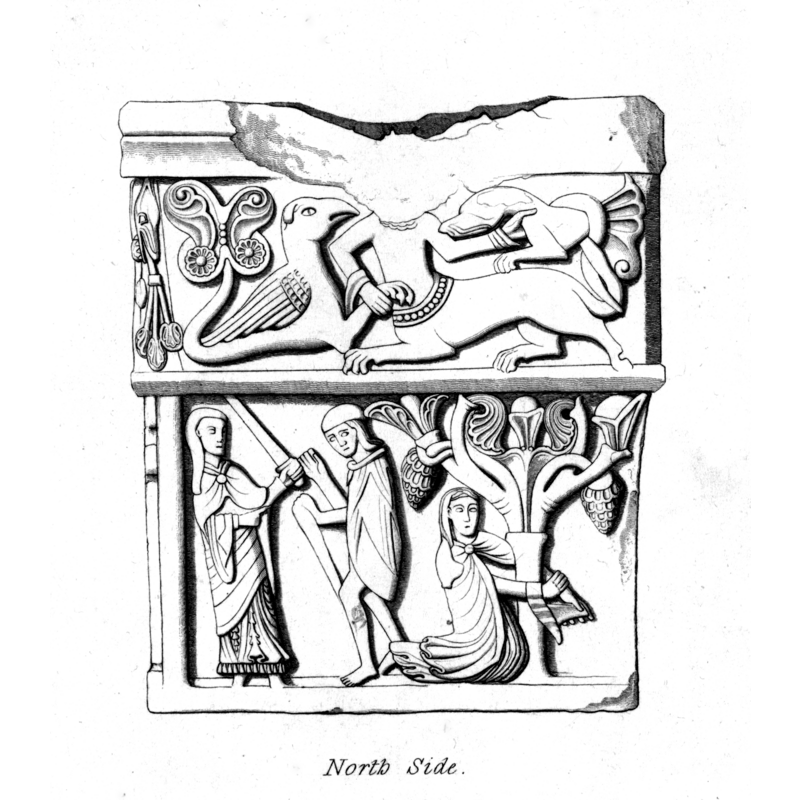
![Illustration in John Bell (1773) ["The drawing of the south and north sides of this font were made this year by one Ainsley, apprentice to Mr. Jefferies; the other two sides by Mr. Elliott, employed by Jefferies to survey the county [...] The characters in which the inscription is contained are here transcribed from the accurate copy of them in the edition of the Britannia"]](/static-50478a99ec6f36a15d6234548c59f63da52304e5/compressed/1050221004_compressed.png)
![[NB: this side of the font is set close against the north wall of the church and therefore very difficult to access; Mr. Rowlinson took this photograph by using a large mirror, then reversed the print to show the correct position and orientation]](/static-50478a99ec6f36a15d6234548c59f63da52304e5/compressed/1060803013_compressed.png)
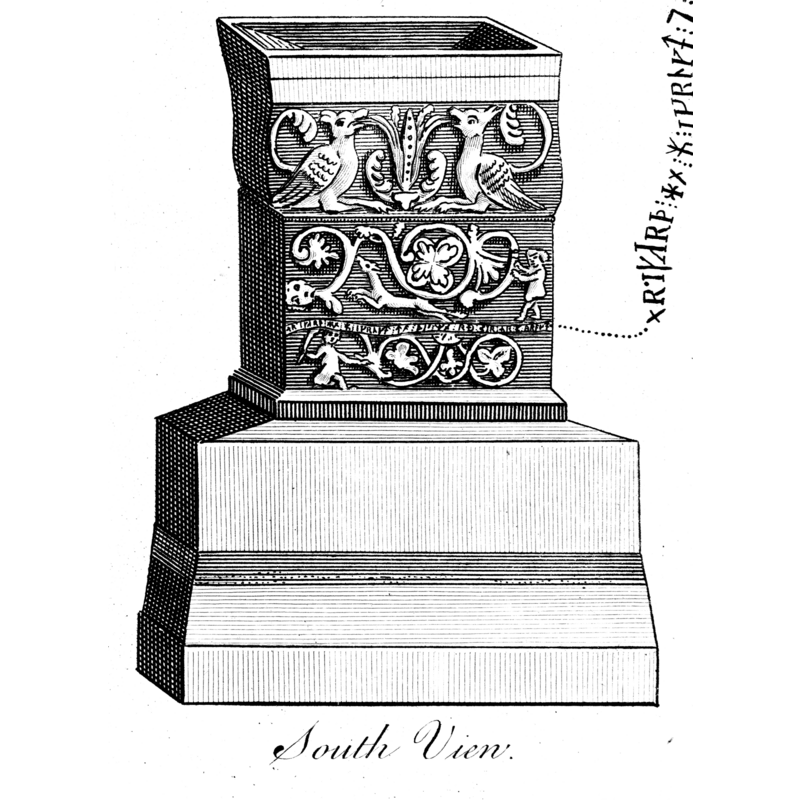
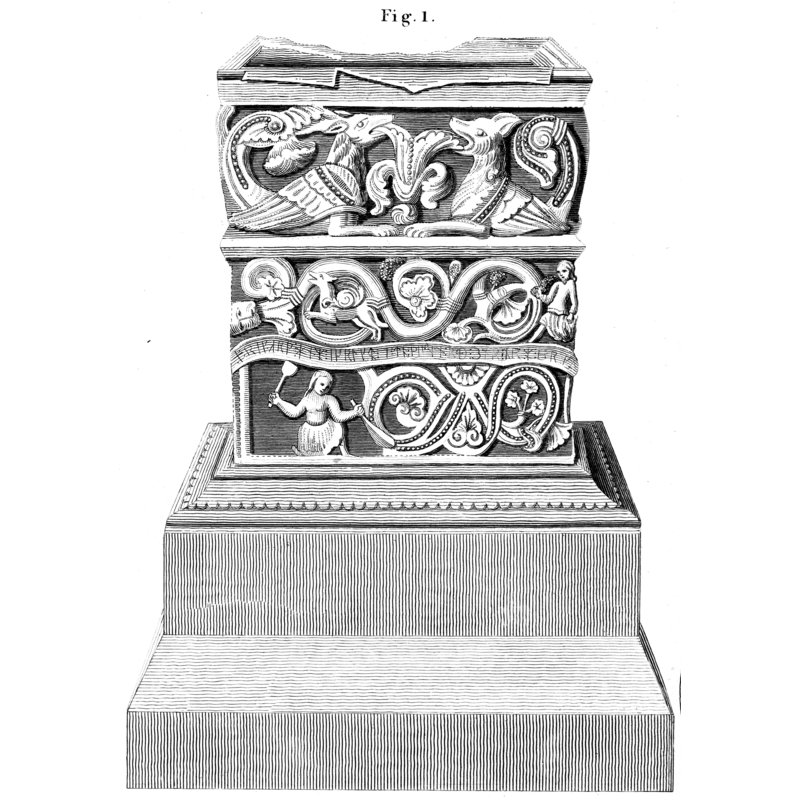
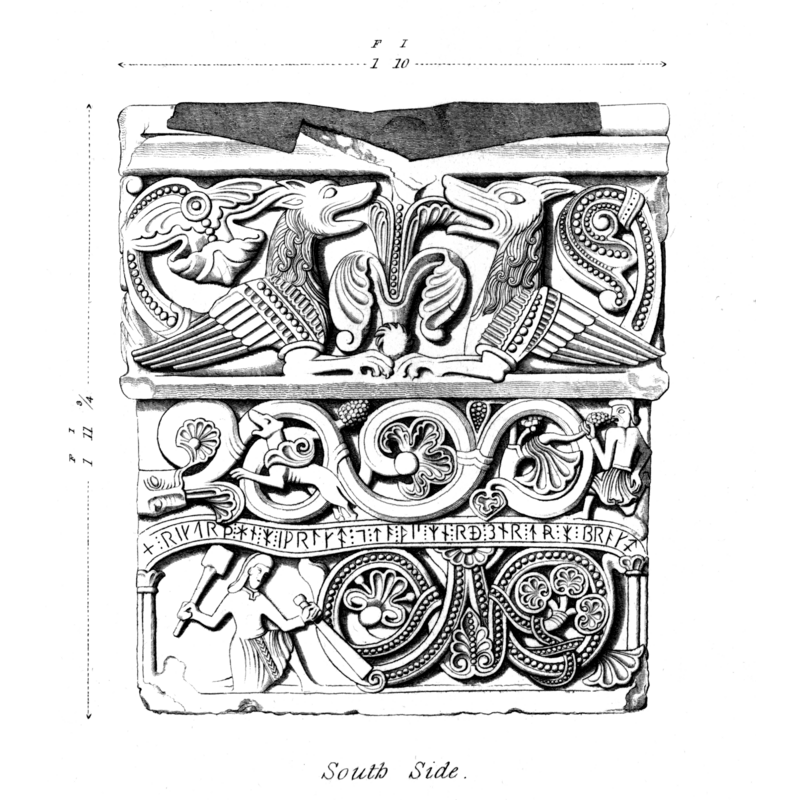
![Illustration in John Bell (1773) ["The drawing of the south and north sides of this font were made this year by one Ainsley, apprentice to Mr. Jefferies; the other two sides by Mr. Elliott, employed by Jefferies to survey the county [...] The characters in which the inscription is contained are here transcribed from the accurate copy of them in the edition of the Britannia"]](/static-50478a99ec6f36a15d6234548c59f63da52304e5/compressed/1050221005_compressed.png)



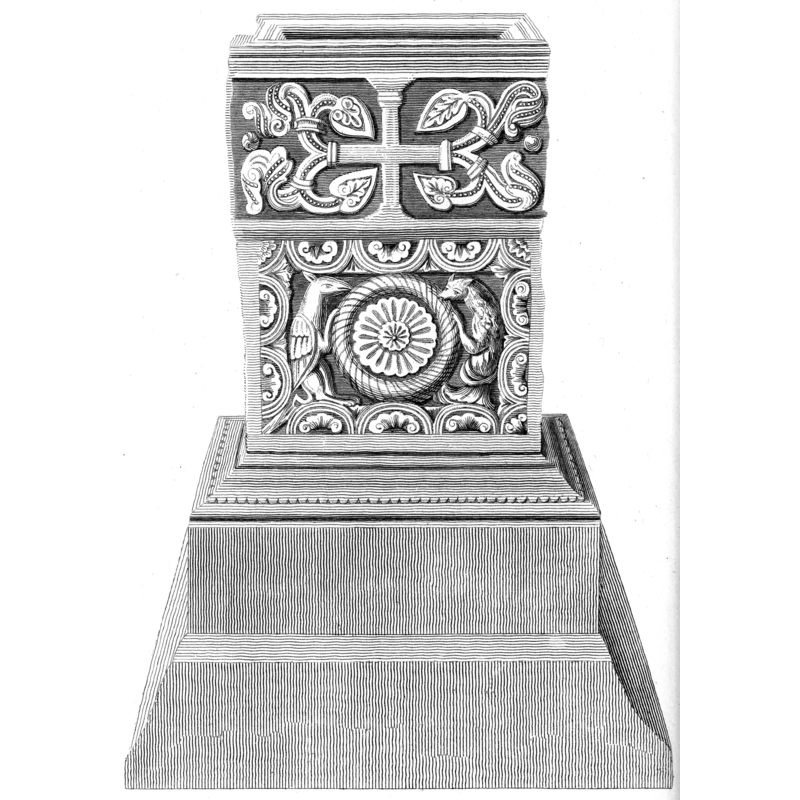

![Illustration in John Bell (1773) ["The drawing of the south and north sides of this font were made this year by one Ainsley, apprentice to Mr. Jefferies; the other two sides by Mr. Elliott, employed by Jefferies to survey the county [...] The characters in which the inscription is contained are here transcribed from the accurate copy of them in the edition of the Britannia"]](/static-50478a99ec6f36a15d6234548c59f63da52304e5/compressed/1050221003_compressed.png)

